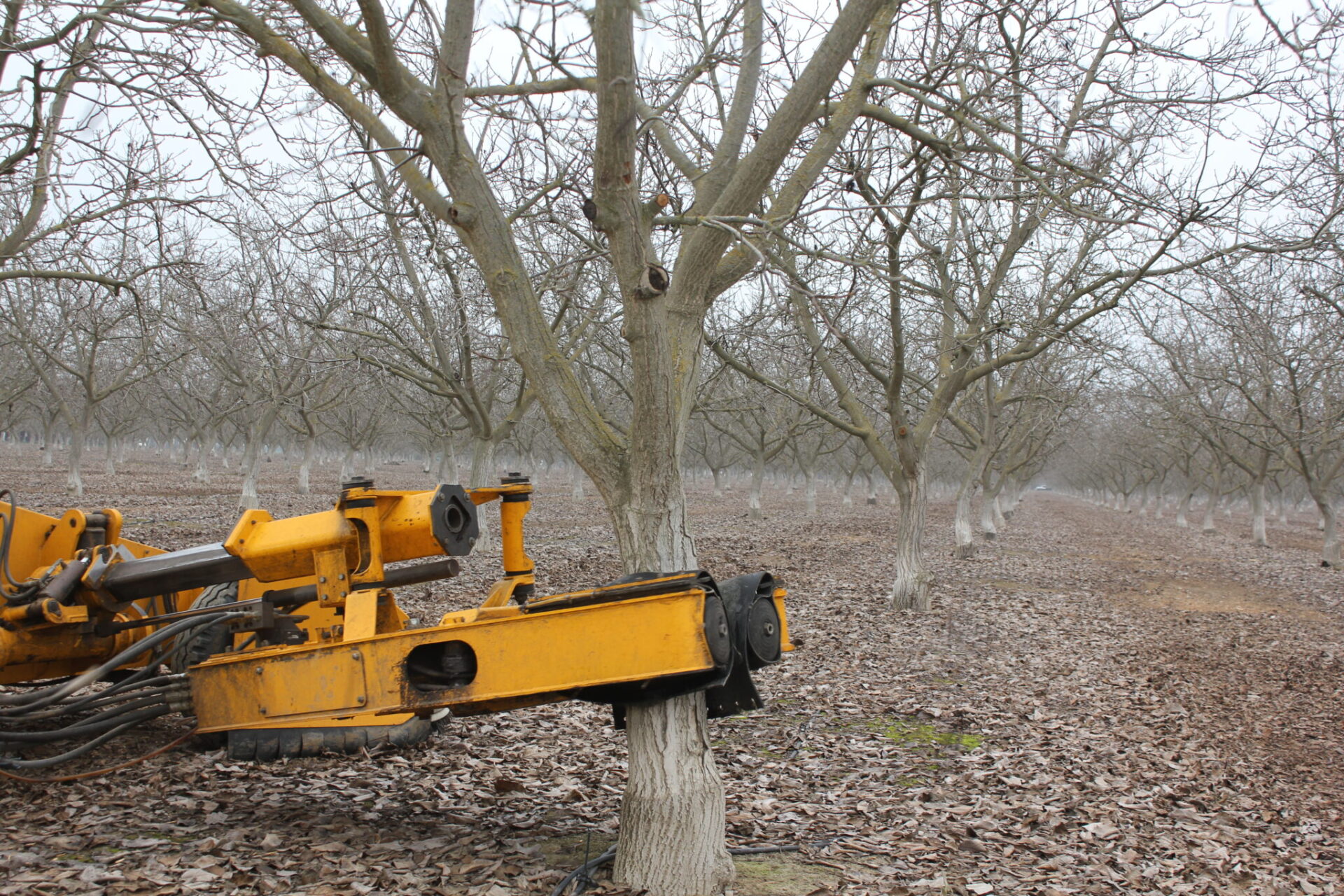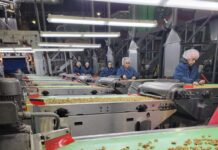
“In walnut orchards, navel orangeworm control starts with codling moth control.”
Houston Wilson, UCCE Specialist (Dept. of Entomology, UC Riverside) at the Kearney Ag Center in Parlier and Director of the newly created UC Organic Agriculture Institute, stressed this point in a recent online Walnut Conference presentation.
Walnuts are generally protected from NOW early in the season when husk integrity is high, since young NOW larvae are unable to chew through this protective covering. In contrast, codling moth larvae can readily bore through walnut husks, and this damage creates an opening for NOW larvae to access new crop walnuts. NOW access to new crop nuts can also be facilitated by blight and sunburn, both of which produce damage to the husk that can provide a point of entry for NOW larvae.
NOW in Walnut Orchards
Research has shown that mummy nuts on the tree and trash nuts left on the ground in orchards provide overwinter sites for NOW larvae. The larvae begin to pupate in March and emerge in April with peak emergence from late April to mid-May, depending on location of the orchard and weather.
NOW are nocturnal, and newly emerged adults exit from pupae at dusk. Female NOW emit a pheromone during the night that allows males to find them. Once the males arrive, the females will mate during the early morning hours and start to deposit eggs the following night. NOW can produce three to four generations per year depending on weather and host quality. Populations develop more rapidly as the season progresses due to warmer weather and the availability of new crop nuts. Although NOW can migrate into an orchard, the size of the first generation emerging from mummy nuts within the orchard in the spring can determine potential for crop damage. Infested mummy nuts left in orchards mean there will be more NOW pressure the following year.
NOW damage in California walnut orchards was first reported in the 1940s. As almonds and later pistachios became more widely planted, NOW became established as a significant insect pest of these orchard crops. NOW damage in walnuts has increased in the past ten years according to Joe Grant, retired UCCE farm advisor and research director for the California Walnut Board, who said orchards in the southern San Joaquin Valley area of Tulare and Kings counties are experiencing serious NOW damage.
Wilson said NOW pressure is not necessarily higher in walnut orchards adjacent to almonds or pistachios, but researchers suspect there is movement of NOW from those crops into walnuts since they are both harvested earlier than walnuts. The California Walnut Board is currently funding a research project to better understand and predict the timing and extent of NOW movement between orchards, led by USDA research entomologist Chuck Burks.
Controlling NOW in Walnuts
Processor tolerance for NOW damage in tree nuts is very low, and growers typically aim for NOW infestation levels of <2%. Infestations in orchards lower yield and quality and lead to higher costs for sorting and processing. Infested mummy nuts left in orchards mean there will be more NOW pressure the following year.
Wilson stressed that there are multiple approaches to NOW control in walnuts. “You want to use a combination of tools and hit them in as many ways as possible,” he said.
Winter sanitation is the foundation of NOW control. Shaking mummies, gathering them into the row middles and then discing or flailing to destroy them will reduce the initial spring flight as well as remove egg laying sites for subsequent generations.
“Winter is the one time of year when moths are static – use that to your advantage, get those mummy nuts out and destroy that base population,” Wilson said.
Cold, wet weather can cause NOW mortality, Wilson said, but growers should not depend on weather alone to control this pest.
Mummies are lower quality hosts compared to new crop nuts, but NOW will continue to use mummies throughout the season. New crop nuts help drive NOW population later by supplying better nutrition to developing larvae.
Research in pistachios, and more recent data from almonds, show that NOW larvae in mummy nuts on the ground tend to fare worse than those in the tree canopy. Additionally, mummies in ground cover or moist bare ground appear to have higher NOW mortality than mummies on dry, bare ground. While not specifically demonstrated in walnuts, these same factors likely apply to NOW in mummy walnuts as well.
Codling moth can be controlled in walnut orchards using a series of well-established protocols that include monitoring, mating disruption and well-timed insecticide sprays, Wilson affirmed. More details on the codling moth control program in walnuts can be found at the UC IPM website (ipm.ucanr.edu/agriculture/walnut/codling-moth/).
There are two parasitoids that suppress NOW in tree nut orchards. Both were imported into California, Wilson said, but are not very effective when aiming for the 2% damage level, as their host population (i.e. NOW) will not be sufficient for significant parasitoid populations to develop in an orchard.
There is evidence that birds and mice could potentially reduce mummy numbers by knocking them to the ground and consuming them, Wilson said, but the reliability of this remains unclear. Research is currently underway by a group at UC Davis to determine how vertebrates can affect NOW populations in walnut orchards.
Mating Disruption
Mating disruption (MD) is a tool used in many almond and pistachio orchards to reduce NOW. Mating disruption uses a synthetic pheromone, which reduces the ability of male NOW to locate females. Various forms of synthetic pheromone emitters can be used in orchards during the growing season. Research carried out by UCCE farm advisor David Haviland in almonds showed that all MD products are effective in reducing NOW infestations. However, Wilson said, mated females can still fly into your blocks, and for this reason suggests that MD will be more effective when used over large, contiguous orchards areas (i.e. large square blocks >40 acres, ideally >100 acres).
MD products will shut down pheromone traps used to monitor NOW numbers, but the phenyl proprionate (PPO) lures will remain attractive as will egg traps. Mating disruption products work best in lower NOW populations, Wilson noted.
“The idea is to get numbers down and keep them down,” Wilson said. The MD products used in Haviland’s trial were used in conjunction with insecticide applications, he noted.
Monitoring
Various traps are available for monitoring NOW in walnut, although trap catch alone cannot be used to predict damage levels. Clear, economic thresholds have not been established for NOW in walnuts, and as such growers must rely on their relative year-to-year experience to make treatment decisions. Available trap types include pheromone lures (attract males) and oviposition baits (i.e. Peterson traps, attract mated females). More recently, PPO lures (attract males and females, but remain attractive under mating disruption) have also become available.
Multiple trap types and more traps per acre will provide more detailed information on NOW populations, as will inspecting damaged nuts on the ground and taking harvest samples. Pheromone and oviposition bait traps typically utilize either a wing-trap or delta trap with sticky liner. These traps should be set out in spring at a rate of one trap per ten acres, if possible, or at least two traps per 40-acre block. Traps should be hung mid-canopy with no foliage interference and checked at least once a week. Replace liners every one to two weeks and lures as recommended by the manufacturer.
Chemical Controls
Wilson said spray timing for chemical control should be based on trap counts and nut inspections. Monitoring data, especially egg deposition at husk split, is also important. If an application is indicated, timing at husk split is most effective.
Insecticides for NOW control are listed on the UC IPM website. These chemical controls include Intrepid, a larvicide, and Altacor, an ovi-larvacide, along with a few pyrethroids. Note that pyrethroids are broad spectrum and can harm beneficial insects, plus NOW resistance to bifenthrin has been recently documented.
Timely Harvest
Harvesting walnuts as soon as possible will reduce their exposure to NOW, Wilson said. Generally speaking, the longer the crop hangs on the tree, the greater probability of NOW damage, especially later in the season when NOW populations are really high. Use of ethephon is an option to speed maturity, but there are cost considerations.
“Growers have multiple tools available to them for NOW, so in many ways it is simply a matter of logistics, planning and execution,” Wilson said.
“Winter sanitation is critical. Whatever you do, develop a management plan, stick to it and use your harvest samples to decide whether or not you need to modify the plan in subsequent years.”










